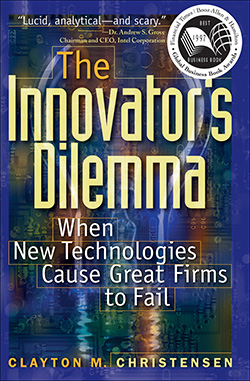Jeff Bezos’ Must-reads: Ten Books That Helped Build Amazon
Even though the man himself claims that nonfiction books taught him less about business than fiction, Jeff Bezos’ favourite reads aren’t fantasy novels, tech thrillers or even whodunits (which are all ever so popular on Amazon), but rather how-tos and management bibles penned by retail tycoons, veterans of the boardroom and innovators in tech industry; in short, by people quite similar to Bezos himself. What may be surprising, though, is just how much has the Amazon CEO learned from his top ten books…
1.
 His first book is „one for the heart”, clearly. It’s The Remains of the Day by Kazuo Ishiguro, brilliantly filmed in a same-titled movie starring Anthony Hopkins. This is about the only book on the list that may simply be here for sentimental reasons, but it speaks volumes about the sensibilities of this man.
His first book is „one for the heart”, clearly. It’s The Remains of the Day by Kazuo Ishiguro, brilliantly filmed in a same-titled movie starring Anthony Hopkins. This is about the only book on the list that may simply be here for sentimental reasons, but it speaks volumes about the sensibilities of this man.
2.
 Number two on the list is the autobiographic Sam Walton: Made in America by Sam Walton, the founder of Wal-Mart. It’s the life of a man who achieved everything by working hard, working smart and learning from his own mistakes. Aside from the very fact that Amazon is now called the online Wal Mart, since it’s got all kinds of products on its virtual shelves and takes after the original retailer giant as far as retail itself goes (low-cost shipping, no centralised warehousing, very low profit margins but very high volume of sales, etc.), there’re less tangible ways in which Walton inspired Amazon’s creator.
Number two on the list is the autobiographic Sam Walton: Made in America by Sam Walton, the founder of Wal-Mart. It’s the life of a man who achieved everything by working hard, working smart and learning from his own mistakes. Aside from the very fact that Amazon is now called the online Wal Mart, since it’s got all kinds of products on its virtual shelves and takes after the original retailer giant as far as retail itself goes (low-cost shipping, no centralised warehousing, very low profit margins but very high volume of sales, etc.), there’re less tangible ways in which Walton inspired Amazon’s creator.
While Bezos prides himself on listening to the opinions of those around him, he often prefers a more „math-crunching” approach – it’s „working smart” at its best. If he sees something as a pure exercise in numbers, he’s trying to rely on them, rather than his team’s instincts alone. For instance, a while back Amazon tried a TV ad campaign. But Bezos didn’t just invest millions into it, he launched a smaller-scale, but lengthy (16-month) ad campaign in just two American cities, and measured the influence of that campaign on sales. Since the results weren’t very encouraging, he went ahead and lowered prices for the products instead, opting for word of mouth on bargains. „That was a long, expensive test,” says Bezos about the trial TV ad campaign, „but we were really determined to understand this for our company once and for all.” Making a mistake in a controlled environment was a lesson well learned and one which is still heeded by Amazon to this day. David Risher, former exec at Amazon, says on the subject; „There’s an X-factor: What will it look like in scale? It’s a big investment, and a big opportunity cost. There’s a leap of faith. Jeff is willing to take those gambles.”
3.
 Memos from the Chairman by Alan „Ace” Greenberg (Bear Sterns’ CEO) sits comfortably at no.3. The book itself is a collection of real-life, humorous memos about modesty and frugality of the employees in his company, used by Ace back in the day to motivate and educate his staff. This clearly inspired Bezos to write his own letter to shareholders every year since the late 1990s, the latest one praising the value of low profit margins and long-term view of the market rather than short-term „stuff your own pockets” mentality that led to the recession. He even shows figures that explain that while net profit margins in the US are soaring in 2013, wages for an average employee sank to their lowest, owing to that policy of high profit margins.
Memos from the Chairman by Alan „Ace” Greenberg (Bear Sterns’ CEO) sits comfortably at no.3. The book itself is a collection of real-life, humorous memos about modesty and frugality of the employees in his company, used by Ace back in the day to motivate and educate his staff. This clearly inspired Bezos to write his own letter to shareholders every year since the late 1990s, the latest one praising the value of low profit margins and long-term view of the market rather than short-term „stuff your own pockets” mentality that led to the recession. He even shows figures that explain that while net profit margins in the US are soaring in 2013, wages for an average employee sank to their lowest, owing to that policy of high profit margins.
Some of the quotes from the book of Memos sound exactly like what Amazon encourages at its HQ: „Forget the chain of command! If you think somebody is going off the wall or his/her decision-making stinks, go around the person, and that includes me.” „Remember that the Green Bay Packers won because they executed the fundamentals better than their competition. Trick plays make headlines, but winners execute the basics.”
4.
 Fourth spot on the list belongs to The Mythical Man-Month by Frederick P. Brooks Jr. This dated (published in 1975) but still great collection of essays should be read by any IT specialist and programmer, as it describes how time constraints, budget, chain of command and various management techniques should be used to improve software projects.
Fourth spot on the list belongs to The Mythical Man-Month by Frederick P. Brooks Jr. This dated (published in 1975) but still great collection of essays should be read by any IT specialist and programmer, as it describes how time constraints, budget, chain of command and various management techniques should be used to improve software projects.
The titular „Mythical Man-Month” is about managing schedules „per person” and why smaller teams get better results, since their creativity is not hampered or stifled by a group. But the real lesson from the book are the so-called „two-pizza teams” implemented at Amazon.
David Risher, who worked at Amazon for a number of years and helped it grow, explained why Bezos insisted on smaller teams to begin with; he says, „People were saying that groups needed to communicate more. Jeff got up and said, ‚No, communication is terrible!'” In this way, Jeff enforced the idea that creativity is borne out of disconnect and individuality, not from order and sheep mentality, the idea no doubt taken from Brooks’ piece. And what are those „two-pizza teams” exactly? „If you can’t feed a team with two pizzas, it’s too large. That limits a task force to five to seven people, depending on their appetites.” says Bezos. Case in point: pizza teams were behind innovations like „special deals”, daily bargains on staple foods and items that are „so low on price, they sink to the very bottom of the website”; bargains which earned the company millions.
5.
 Number five on Bezos’ all-time faves list is Built to Last: Successful Habits of Visionary Companies by Jim Collins. One of two management how-tos by Collins on this list is also the one that helped create Amazon’s core ideology and explains why everyone at a modern successful company needs to be on board with the company’s mission and direction.
Number five on Bezos’ all-time faves list is Built to Last: Successful Habits of Visionary Companies by Jim Collins. One of two management how-tos by Collins on this list is also the one that helped create Amazon’s core ideology and explains why everyone at a modern successful company needs to be on board with the company’s mission and direction.
For Amazon, since day one it was „customer-centric company” — its actually something that Bezos reiterates almost every time he’s interviewed about Amazon. One example of this, given in an article in FastCompany, is that Bezos sometimes completely disregards everything that number-crunching and statistics tell him. A while back it appeared that some of the biggest individual clients of the website bought items for their collections – e.g. CD or DVD collections. Since their collections were very large, they would sometimes buy things they’d bought earlier by mistake. In response, Amazon introduced a new feature which actually warns you if you’re about to buy something you’ve purchased already. It did hurt short-term sales of the company, but according to Bezos, if it’s good for the customer, the company wins: „In cases like that, we say, ‚Let’s be simple-minded. We know this is a feature that’s good for customers. Let’s do it.'”
6.
 Sixth on this list is another best seller by Jim Collins, entitled Good to Great: Why Some Companies Make the Leap… and Others Don’t. This „business bible” was first presented to Amazon managers even before it was published — so they could take it to heart there and then. Collins’ second offering contains a few core slogans that ring very true when looking at Amazon:
Sixth on this list is another best seller by Jim Collins, entitled Good to Great: Why Some Companies Make the Leap… and Others Don’t. This „business bible” was first presented to Amazon managers even before it was published — so they could take it to heart there and then. Collins’ second offering contains a few core slogans that ring very true when looking at Amazon:
„First Who…Then What”: Bezos’ typical strategy to this day is first hiring talent, then using that talent to some specific goals. It is also a lesson he learned from the next book on his list.
„Confront the Brutal Facts”: Bezos’ shareholders letter that is based on book no. 3 on the list is usually very truthful and revealing, even if the reality may not be very rosy.
„The Flywheel„: In order to build momentum with the company, constant, small actions are needed. Even though it seems to contradict the approach from bottom to top, described in the next book on Bezos’ list, it’s still an important part of Amazon strategy.
„Disciplined Action”: According to Collins’ research, on average it took companies 4 or more years to succeed with their product. Amazon is a very good example of that same strategy, enduring and staying the course. Lowering their prices, offering free shipment on purchases above USD 25, undercutting themselves by offering users to sell their own items at lower cost than Amazon’s own store — those were all risky moves that only paid off many years down the line. „You can do the math 15 different ways, and every time the math tells you that you shouldn’t lower prices ’cause you’re gonna make less money. That’s undoubtedly true in the current quarter, in the current year. But it’s probably not true over a 10-year period, when the benefit is going to increase the frequency with which your customers shop with you,” says Bezos; this stick-to-itiveness shows time and time again in Amazon’s history.
7.
 Number seven goes to a surprising philosophical book about artificial life and computers – Creation: Life and How to Make It by Steve Grand. According to The Week, this book in particular helped Bezos create AWS, Amazon Web Services – the core of Amazon success story. But it goes deeper than that.
Number seven goes to a surprising philosophical book about artificial life and computers – Creation: Life and How to Make It by Steve Grand. According to The Week, this book in particular helped Bezos create AWS, Amazon Web Services – the core of Amazon success story. But it goes deeper than that.
In fact, the basic idea from this book may be that you have to start at the very bottom, at the very simplest level, and not micromanage everything. Grand argues that the structure and the basic building blocks aid the „shaping” process of any complex system. In case of Amazon the most basic building blocks are people. And Bezos himself famously said, „I’d rather interview 50 people and not hire anyone than hire the wrong person”. According to him, it’s very important to hire a few very talented people who are not afraid to innovate and say no, so that the rest can happen organically.
8.
 Eighth book on the list is a breakthrough technology-related piece, The Innovator’s Dilemma by Clayton Christensen. Published at a time when the dotcom boom was a very real thing and something to dread, this is one of the most influential titles in the tech industry to this day. In a nutshell, „The Innovator’s Dilemma” is about two things; first, there’s somethig called „disruptive technology”, some new and advanced technology that starts as a novelty thing (think tablets 20 years ago), but over time grows into a huge market, helping early adopters to make a mint. In case of Amazon, one such „disruptive technology” was e-ink, used to the company’s huge advantage with Amazon’s Kindle. Another notion presented by Christensen is a roadmap to stay ahead of the curve as far as tech products go; the lesson here is that every technology is sooner or later becoming mass-produced and extremely cheap, eventually making it less profitable for the early adopter to sell it. This is why all the companies need to constantly evolve and innovate; while Kindle was an example of first-use disruptive tech, Kindle Fire would be an example of breaking new ground for Amazon.
Eighth book on the list is a breakthrough technology-related piece, The Innovator’s Dilemma by Clayton Christensen. Published at a time when the dotcom boom was a very real thing and something to dread, this is one of the most influential titles in the tech industry to this day. In a nutshell, „The Innovator’s Dilemma” is about two things; first, there’s somethig called „disruptive technology”, some new and advanced technology that starts as a novelty thing (think tablets 20 years ago), but over time grows into a huge market, helping early adopters to make a mint. In case of Amazon, one such „disruptive technology” was e-ink, used to the company’s huge advantage with Amazon’s Kindle. Another notion presented by Christensen is a roadmap to stay ahead of the curve as far as tech products go; the lesson here is that every technology is sooner or later becoming mass-produced and extremely cheap, eventually making it less profitable for the early adopter to sell it. This is why all the companies need to constantly evolve and innovate; while Kindle was an example of first-use disruptive tech, Kindle Fire would be an example of breaking new ground for Amazon.
9.
 Ninth book on the list is, quite surprisingly, an actual novel. The Goal: A Process of Ongoing Improvements by Eliyahu Goldratt is a complex metaphor based around a fictitious plant that suffers from several issues. It’s clear that as any good manager, this book speaks to Bezos on many levels, but perhaps most significantly in terms of the TOC – the Theory of Constraints, in which you identify the weakest parts of your business first, and build your company’s success around these weakest parts, not in spite of them. One may argue that lack of physical stores, warehousing and very simplified logistics (at least back at the beginning) would hinder Amazon – but Bezos built the company specifically around that particular weak spot, making it a genius move instead. It very well may be that he learned this trick from Goldratt…
Ninth book on the list is, quite surprisingly, an actual novel. The Goal: A Process of Ongoing Improvements by Eliyahu Goldratt is a complex metaphor based around a fictitious plant that suffers from several issues. It’s clear that as any good manager, this book speaks to Bezos on many levels, but perhaps most significantly in terms of the TOC – the Theory of Constraints, in which you identify the weakest parts of your business first, and build your company’s success around these weakest parts, not in spite of them. One may argue that lack of physical stores, warehousing and very simplified logistics (at least back at the beginning) would hinder Amazon – but Bezos built the company specifically around that particular weak spot, making it a genius move instead. It very well may be that he learned this trick from Goldratt…
10.
 Last but not least on the list is ‚the holy book of Toyota’, Lean Thinking: Banish Waste and Create Wealth in Your Corporation by James Womanck. The whole notion of Lean management style is an incredibly evolved concept nowadays, and many companies (like Toyota) are working to its standards. But it seems that Amazon has started out with that particular goal in mind – Bezos envisaged a very simple business model that required no additional human resources and specific infrastructure, and could keep his business lean even growing into a multibillion dollar company.
Last but not least on the list is ‚the holy book of Toyota’, Lean Thinking: Banish Waste and Create Wealth in Your Corporation by James Womanck. The whole notion of Lean management style is an incredibly evolved concept nowadays, and many companies (like Toyota) are working to its standards. But it seems that Amazon has started out with that particular goal in mind – Bezos envisaged a very simple business model that required no additional human resources and specific infrastructure, and could keep his business lean even growing into a multibillion dollar company.
So what do you think – are you ready to read what he did and start on your own journey towards success? Perhaps you could follow Jeff Bezos’ example and start your own company; and if Amazon is any indication, the lessons within are well worth learning.
VOCABULARY
nonfiction books – literatura faktu
fiction – beletrystyka
whodunit – kryminał
how-to – praktyczny poradnik
to pen – napisać (książkę)
retail – detal, sprzedaż detaliczna
tycoon – potentat
boardroom – szczebel kierowniczy
CEO (Chief Executive Officer) – dyrektor naczelny
brilliantly – wspaniale, wyśmienicie
same-titled – pod tym samym tytułem
to star – występować (w filmie)
founder – założyciel
to achieve – osiągnąć
to take after sb – pójść w czyjeś ślady, naśladować kogoś
shipping – spedycja
warehousing – składowanie
profit margin – marża
volume – objętość
tangible – namacalny
to pride oneself on doing sth – móc się szczycić tym, że się coś robi
math-crunching – rozwiązywanie problemów matematycznych, obracanie liczbami
exercise in sth – lekcja czegoś
to rely on sth – polegać na czymś
ad (advertisement) – reklama
to launch – rozpocząć, wystartować
small-scale – niewielkich rozmiarów
to measure – zmierzyć
influence – wpływ
encouraging – zachęcający, pozytywny
to opt for sth – optować za czymś
word of mouth – reklama z ust do ust, polecanie sobie nawzajem produktu
bargain – okazja cenowa
trial – próbny
a lesson well learned – nauczka na przyszłość
to heed sth – przysłuchać się czemuś
former – były, dawny
exec (executive) – dyrektor, menadżer wyższego szczebla
a leap of faith – skok wiary, zdanie się na łaskę losu
willing – chętny
gamble – ryzyko
memo – notka służbowa
modesty – skromność
frugality – oszczędność
staff – pracownicy
shareholder – udziałowiec
to praise – chwalić
value – wartość
long-term – długoterminowy
to stuff one’s pockets – wypchać sobie kieszenie
figure – liczba, statystyka
net – netto
soaring – osiągający niebotyczne wysokości
owing to sth – z powodu czegoś
HQ (headquarters) – siedziba główna
chain of command – hierarchia służbowa
to go off the wall – szaleć
to stink – być do bani (pot.)
fundamentals – podstawowe zasady/umiejętności
competition – rywal
to make headlines – trafić na nagłówki
to execute – wykonywać
dated – przestarzały, starawy
IT (information technology) – informatyka
constraint – ograniczenie
various – rozmaity
schedule – plan, harmonogram
to hamper – hamować, utrudniać
to stifle – dławić, tłumić
so-called – tak zwany
to insist on sth – nalegać na czymś
to enforce – umocnić
to be borne out of sth – wyłonić się z czegoś
disconnect – oderwanie, oddzielenie
no doubt – bez wątpienia
task force – grupa robocza
depending on – w zależności od
case in point – dobry przykład
staple foods – produkty spożywcze
fave – ulubiona osoba lub rzecz (pot.)
core – kluczowy, podstawowy
to be on board with sth – akceptować coś, przyjmować coś
customer-centric company – spółka zorientowana na klienta
to reiterate – powtarzać
to disregard – zlekceważyć
in response – w reakcji (na coś)
feature – cecha, funkcja
to warn – ostrzec
to purchase – nabyć
according to – zgodnie z, według
simple-minded – prosty, prostoduszny
to take sth to heart – brać sobie coś do serca
offering – tu: produkt
to ring true – brzmieć prawdziwie
goal – cel
truthful – prawdziwy, szczery
revealing – wiele mówiący
rosy – różowy (np. o sytuacji)
flywheel – koło zamachowe
momentum – popęd, rozpęd
constant – stały
to contradict – zaprzeczać
research – badania
on average – przeciętnie
to succeed – osiągnąć sukces
to endure – wytrwać
to stay the course – utrzymać ten sam kurs
to undercut – podkopać, obniżyć (ceny w por. do konkurenta)
to pay off – zwrócić się, opłacić się
down the line – w przyszłości
to do the math – obliczyć coś, przekalkulować
undoubtedly – bez wątpienia
benefit – korzyść
frequency – częstotliwość
stick-to-itiveness – konsekwencja w działaniu, trzymanie się raz obranego kursu (pot.)
artificial – sztuczny
in particular – w szczególności
to micromanage – wtrącać się w działanie firmy, kontrolować wszystko od A do Z (o dyrektorze spółki)
to argue – przekonywać
to aid – wspierać
complex – skomplikowany
famously – w pamiętny sposób
organically – organicznie, tu: naturalnie, w niewymuszony sposób
breakthrough – przełomowy
dotcom boom – okres ogromnej (acz krótkotrwałej) popularności serwisów internetowych z adresem kończącym się na .com
to dread – bać się
in a nutshell – pokrótce
disruptive – tu: przełomowy, wywrotowy
novelty – nowinka, ciekawostka
early adopter – ktoś, kto jako pierwszy dostrzega potencjał jakiejś nowinki i na niej zarabia
to make a mint – zbić majątek
advantage – korzyść
notion – koncepcja, idea
roadmap – mapa działań, gryplan
to stay ahead of the curve – nie dać się wyprzedzić konkurencji, wiedzieć, co się kroi
extremely – niezwykle, ogromnie
eventually – w końcu
profitable – dochodowy
first-use – pierwszego użytku, tu: debiutancki
actual – faktyczny
novel – powieść
fictitious – fikcyjny
plant – fabryka
to suffer from sth – cierpieć na coś/z powodu czegoś
in terms of – pod względem, w zakresie
in spite of – pomimo
lack – brak
to hinder – przeszkodzić, zahamować
last but not least – ostatni, lecz nie najmniej ważny
holy – święty
management style – styl/sposób zarządzania
nowadays – obecnie
with sth in mind – mając coś na uwadze
to envisage – przewidzieć, wyobrazić
to require – wymagać
lean – chudy (odtłuszczony), pozbawiony zbędnych dodatków/wagi
if sth is any indication… – jeśli uznać coś za dobry wyznacznik (czegoś), to…
-by Prochor Aniszczuk







